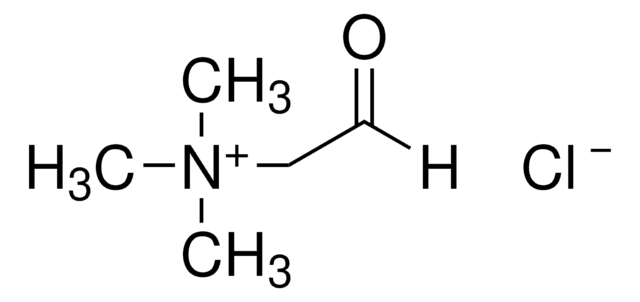Products may be shipped at a different temperature than the recommended long-term storage temperature. If the product quality is sensitive to short-term exposure to conditions other than the recommended long-term storage, it will be shipped on wet or dry-ice. If the product quality is NOT affected by short-term exposure to conditions other than the recommended long-term storage, it will be shipped at ambient temperature. As shipping routes are configured for minimum transit times, shipping at ambient temperature helps control shipping costs for our customers. For more information, please refer to the Storage and Transport Conditions document: https://www.sigmaaldrich.com/deepweb/assets/sigmaaldrich/marketing/global/documents/316/622/storage-transport-conditions-mk.pdf
50053
Cloreto de glicidiltrimetilamônio
technical, ≥90% (calc. based on dry substance, AT)
Sinônimo(s):
Cloreto de (2,3-epoxipropil)trimetilamônio
About This Item
Produtos recomendados
grau
technical
Nível de qualidade
Ensaio
≥90% (calc. based on dry substance, AT)
Impurezas
2-4% chlorohydrin
20-25% water
densidade
1.13 g/mL at 20 °C (lit.)
temperatura de armazenamento
2-8°C
cadeia de caracteres SMILES
[Cl-].C[N+](C)(C)CC1CO1
InChI
1S/C6H14NO.ClH/c1-7(2,3)4-6-5-8-6;/h6H,4-5H2,1-3H3;1H/q+1;/p-1
chave InChI
PUVAFTRIIUSGLK-UHFFFAOYSA-M
Procurando produtos similares? Visita Guia de comparação de produtos
Categorias relacionadas
Descrição geral
Aplicação
Atenção
produto relacionado
Palavra indicadora
Danger
Frases de perigo
Declarações de precaução
Classificações de perigo
Acute Tox. 4 Dermal - Acute Tox. 4 Inhalation - Acute Tox. 4 Oral - Aquatic Chronic 3 - Carc. 1B - Eye Dam. 1 - Muta. 2 - Repr. 1B - Skin Sens. 1 - STOT RE 2 - STOT SE 2
Órgãos-alvo
Kidney
Código de classe de armazenamento
6.1C - Combustible acute toxic Cat.3 / toxic compounds or compounds which causing chronic effects
Classe de risco de água (WGK)
WGK 3
Ponto de fulgor (°F)
338.0 °F - closed cup
Ponto de fulgor (°C)
170 °C - closed cup
Equipamento de proteção individual
Eyeshields, Faceshields, Gloves, type P3 (EN 143) respirator cartridges
Escolha uma das versões mais recentes:
Já possui este produto?
Encontre a documentação dos produtos que você adquiriu recentemente na biblioteca de documentos.
Os clientes também visualizaram
-
How is shipping temperature determined? And how is it related to the product storage temperature?
1 answer-
Helpful?
-
-
How can I determine the shelf life / expiration / retest date of this product?
1 answer-
If this product has an expiration or retest date, it will be shown on the Certificate of Analysis (COA, CofA). If there is no retest or expiration date listed on the product's COA, we do not have suitable stability data to determine a shelf life. For these products, the only date on the COA will be the release date; a retest, expiration, or use-by-date will not be displayed.
For all products, we recommend handling per defined conditions as printed in our product literature and website product descriptions. We recommend that products should be routinely inspected by customers to ensure they perform as expected.
For products without retest or expiration dates, our standard warranty of 1 year from the date of shipment is applicable.
For more information, please refer to the Product Dating Information document: https://www.sigmaaldrich.com/deepweb/assets/sigmaaldrich/marketing/global/documents/449/386/product-dating-information-mk.pdfHelpful?
-
-
From this information “Caution hydrolysis on storage (approx. 3.5%/month at 20°C)” If I keep in storage -18 °C it’s can keep product from approx.? Or reduce some loss?
1 answer-
The recommended storage temperature for the product is 2-8 °C. The retest period for this item is approximately one year from the quality release date when stored in these conditions. There is no stability information available regarding storage at -18°C.
Helpful?
-
-
>90% Glycidyltrimethylammonium Chloride (#50053) has a water content between 20-25%. What would be the refractive index at a water content of 20 and 25%?
1 answer-
The refractive index is not determined.
Helpful?
-
Active Filters
Nossa equipe de cientistas tem experiência em todas as áreas de pesquisa, incluindo Life Sciences, ciência de materiais, síntese química, cromatografia, química analítica e muitas outras.
Entre em contato com a assistência técnica

![[2-(Acryloyloxy)ethyl]trimethylammonium chloride solution 80 wt. % in H2O, contains 600 ppm monomethyl ether hydroquinone as inhibitor](/deepweb/assets/sigmaaldrich/product/structures/393/326/f7e19585-5431-4220-81b5-f458de6d63d0/640/f7e19585-5431-4220-81b5-f458de6d63d0.png)




![[2-(Methacryloyloxy)ethyl]trimethylammonium chloride solution 75 wt. % in H2O](/deepweb/assets/sigmaaldrich/product/structures/316/612/66b0f4cf-d060-427d-b4f5-e8fab3e5cffe/640/66b0f4cf-d060-427d-b4f5-e8fab3e5cffe.png)








